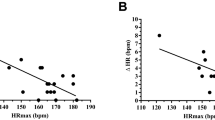Abstract
Purpose
Self-paced \(\dot{V}{\text{O}}_{2\hbox{max} }\) tests (SPVs) have shown to produce maximal oxygen consumption values similar to those from traditional protocols. These tests involve perceptually regulated stages in which subjects are asked to maintain rating of perceived exertion values of 11, 13, 15, 17 and 20 for 2 min each. What is not clear is how the last stage should be paced. The purpose of this study was to compare two different pacing strategies during the final stage.
Methods
Fourteen healthy, recreationally active individuals (11 men, 3 women) participated in a familiarization and two experimental laboratory visits. For both lab visits, a treadmill-based SPV was performed. In one of these SPVs, an aggressive pacing strategy was used; in the other, a conservative strategy was implemented. \(\dot{V}{\text{O}}_{2\hbox{max} }\), HR, \(\dot{V}_{\text{E}}\), \(\dot{V}{\text{CO}}_{2}\) and RER were recorded and compared between conditions.
Results
There were no differences in \(\dot{V}{\text{O}}_{2\hbox{max} }\) between the conditions [aggressive 58.8 ± 8.8 ml kg−1 min−1 (mean ± SD), conservative 58.3 ± 7.9 ml kg−1 min−1; p = 0.548]. There were also no differences in HR, \(\dot{V}_{\text{E}}\), or \(\dot{V}{\text{CO}}_{2}\) between the pacing strategies. There was a significantly higher RER found in the aggressive (1.25 ± 0.09) compared to the conservative (1.18 ± 0.07) strategy (p = 0.040).
Conclusions
The pacing strategy that is implemented in the last 2 min of an SPV on a treadmill does not affect the maximal oxygen consumption that is elicited during that test. Either pacing strategy can be used for this protocol without compromising the results, when \(\dot{V}{\text{O}}_{2\hbox{max} }\) is the variable of interest.



Similar content being viewed by others
Abbreviations
- GXT:
-
Graded exercise test
- HR:
-
Heart rate
- PO:
-
Power output
- PRET:
-
Perceptually regulated exercise test
- RER:
-
Respiratory exchange ratio
- RPE:
-
Rating of perceived exertion
- SPV:
-
Self-paced \(\dot{V}{\text{O}}_{2\hbox{max} }\) test
- \(\dot{V}{\text{CO}}_{2}\) :
-
Rate of carbon dioxide production
- \(\dot{V}_{\text{E}}\) :
-
Rate of minute ventilation
- \(\dot{V}{\text{O}}_{2}\) :
-
Rate of oxygen consumption
- \(\dot{V}{\text{O}}_{2\hbox{max} }\) :
-
Maximal rate of oxygen consumption
References
Astorino T, White A, Dalleck L (2009) Supramaximal testing to confirm attainment of VO2max in sedentary men and women. Int J Sports Med 30:279–284
Astorino TA, McMillan DW, Edmunds RM, Sanchez E (2015) Increased cardiac output elicits higher VO2max in response to self-paced exercise. Appl Physiol Nutr Metab 40:223–229
Beltz NM, Gibson AL, Janot JM, Kravitz L, Mermier CM, Dalleck LC (2016) Graded exercise testing protocols for the determination of VO2max: historical perspectives, progress, and future considerations. J Sports Med 2016:3968393
Borg GA (1982) Psychophysical bases of perceived exertion. Med Sci Sports Exerc 14:377–381
Carter H, Pringle J, Barstow T, Doust J (2006) Oxygen uptake kinetics during supra VO2max treadmill running in humans. Int J Sports Med 27:149–157
Chidnok W, DiMenna FJ, Bailey SJ, Burnley M, Wilkerson DP, Vanhatalo A, Jones AM (2013a) VO2max is not altered by self-pacing during incremental exercise. Eur J Appl Physiol 113:529–539
Chidnok W, DiMenna FJ, Bailey SJ, Burnley M, Wilkerson DP, Vanhatalo A, Jones AM (2013b) VO2max is not altered by self-pacing during incremental exercise: reply to the letter of Alexis R. Mauger. Eur J Appl Physiol 113:543–544
Eston RG, Thompson M (1997) Use of ratings of perceived exertion for predicting maximal work rate and prescribing exercise intensity in patients taking atenolol. Br J Sports Med 31:114–119
Eston RG, Lamb KL, Parfitt G, King N (2005) The validity of predicting maximal oxygen uptake from a perceptually-regulated graded exercise test. Eur J Appl Physiol 94:221–227
Faulkner J, Mauger AR, Woolley B, Lambrick D (2015) The efficacy of a self-paced VO2max test during motorized treadmill exercise. Int J Sports Physiol Perform 10:99–105
Hanson NJ, Scheadler CM, Lee TL, Neuenfeldt NC, Michael TJ, Miller MG (2016) Modality determines VO2max achieved in self-paced exercise tests: validation with the Bruce protocol. Eur J Appl Physiol 116:1313–1319
Jenkins LA, Mauger AR, Hopker JG (2017) Age differences in physiological responses to self-paced and incremental VO2max testing. Eur J Appl Physiol 117:159–170
Mauger A (2013) VO2max is altered by self-pacing during incremental exercise. Eur J Appl Physiol 113:541–542
Mauger AR, Sculthorpe N (2012) A new VOmax protocol allowing self-pacing in maximal incremental exercise. Br J Sports Med 46:59–63
Mauger AR, Metcalfe AJ, Taylor L, Castle PC (2013) The efficacy of the self-paced VO2max test to measure maximal oxygen uptake in treadmill running. Appl Physiol Nutr Metab 38:1211–1216
Midgley AW, McNaughton LR, Carroll S (2006) Verification phase as a useful tool in the determination of the maximal oxygen uptake of distance runners. Appl Physiol Nutr Metab 31:541–548. doi:10.1139/h06-023
Robergs RA, Dwyer D, Astorino T (2010) Recommendations for improved data processing from expired gas analysis indirect calorimetry. Sports Med 40:95–111
Scharhag-Rosenberger F, Carlsohn A, Cassel M, Mayer F, Scharhag J (2011) How to test maximal oxygen uptake: a study on timing and testing procedure of a supramaximal verification test. Appl Physiol Nutr Metab 36:153–160. doi:10.1139/H10-099
Scheadler CM, Devor ST (2015) VO2max measured with a self-selected work rate protocol on an automated treadmill. Med Sci Sports Exerc 47:2158–2165
Straub AM, Midgley AW, Zavorsky GS, Hillman AR (2014) Ramp-incremented and RPE-clamped test protocols elicit similar VO2max values in trained cyclists. Eur J Appl Physiol 114:1581–1590
Thompson WR, Gordon NF, Pescatello LS (2009) ACSM’s guidelines for exercise testing and prescription, 8th edn. Lippincott Williams & Wilkins, Philadelphia
Author information
Authors and Affiliations
Corresponding author
Ethics declarations
Conflict of interest
None of the authors have any conflicts of interest to declare.
Funding
No funding sources were used for this study.
Additional information
Communicated by Peter Krustrup.
Rights and permissions
About this article
Cite this article
Hanson, N.J., Reid, C.R., Cornwell, K.M. et al. Pacing strategy during the final stage of a self-paced \(\dot{V}{\text{O}}_{2\hbox{max} }\) (SPV) test does not affect maximal oxygen uptake. Eur J Appl Physiol 117, 1807–1815 (2017). https://doi.org/10.1007/s00421-017-3656-3
Received:
Accepted:
Published:
Issue Date:
DOI: https://doi.org/10.1007/s00421-017-3656-3




